WOOD-BORING INSECTS AND LARVAE
WOOD-BORING INSECTS AND LARVAE
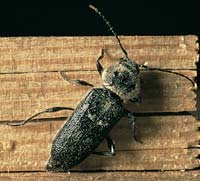 WHAT IT ATTACKS :
WHAT IT ATTACKS :
- Sapwood in softwood timber.
SIGNS OF DAMAGE :
- Passage-ways running along the grain of the wood containing frass
- Oval-shaped exit holes between 5 to 10 mm.
MORPHOLOGY :
- Larva:
- 20 to 25 mm, ivory-white colour
- larvae cycle: 3 to 5 years
- Insect:
- 10 to 20 mm, dark brown colour
- Lives 2 to 3 weeks
- Lays 40 to 100 eggs.
 WHAT IT ATTACKS :
WHAT IT ATTACKS :
- Sapwood in softwood
SIGNS OF DAMAGE :
- Passage-ways running along the grain of the wood containing frass
- Oval-shaped exit holes between 5 to 10 mm.
MORPHOLOGY :
- Larva:
- 20 to 25 mm, whitish colour
- Larvae cycle: 3 to 5 years
- Insect:
- 10 to 20 mm, dark brown colour
- Lives 2 to 3 weeks
- Lays 40 to 100 eggs
DEATHWATCH BEETLE (XESTOBIUM RUFOVILLOSUM)
WHAT IT ATTACKS:
- Construction timber (softwoods and hardwoods) often with fungal decay
SIGNS OF DAMAGE:
- Passage-ways running along the grain of the wood containing wood dust
- Circular exit holes, 1 to 3 mm (4 mm for large beetles)
MORPHOLOGY :
- Small woodworm:
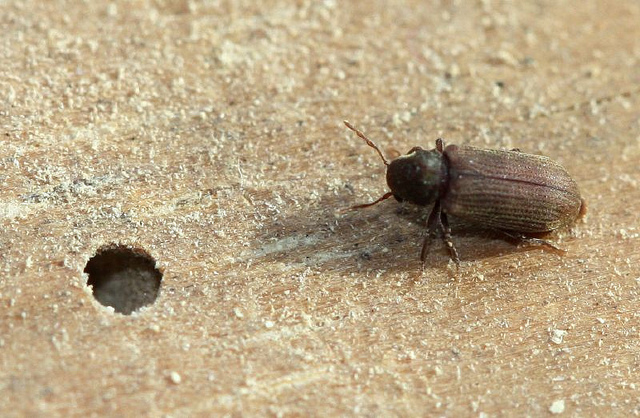
- Larva
- Curved, 5 to 7 mm, whitish colour
- Larvae cycle: 1 to 4 years
- Adult
- 2,5 mm to 5 mm, dark brown colour
- Lives 3 to 4 weeks
- Lays 20 to 30 eggs
- Larva
- Large woodworm:
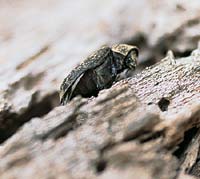
- Larva
- Curved, whitish colour, 6 to 11 mm,
- Hairy
- Larva cycle: 1 to 10 years depending on the wood’s fungal decay
- Adult
- 5 to 7 mm.
- Dark brown colour, with tufts of yellow hair
- Lives about 9 weeks
- Lays 100 eggs.
- Larva
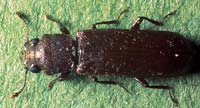 WHAT IT ATTACKS :
WHAT IT ATTACKS :
- Tropical and European hardwoods.
SIGNS OF DAMAGE :
- Numerous passage-ways filled with frass
- Circular exit holes, 1 to 2 mm.
MORPHOLOGY :
- Larva:
- 5 to 7 mm, whitish colour
- Larvae cycle: 8 to 12 months
- Insect:
- 3 to 6 mm: reddish brown
- Lives 2 to 6 weeks
- Lays around 20 eggs.
NESTING INSECTS
Hyménoptère xylocopidée
WHAT IT ATTACKS
- Hardwoods and softwoods
SIGNS OF DAMAGE
- Passage-ways 10 to 15 mm in diameter and 45 cm in length
- Evidence of wood chips of beside the timber
MORPHOLOGY
- Appearance: resembles a bumble bee
- Colour: black body with violet tinted wings
- Length: 20 to 25 mm
WHAT IT ATTACKS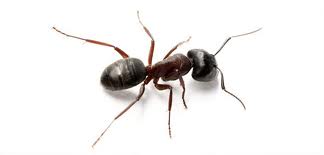
All wood, particularly with dry rot
SIGNS OF DAMAGE
- Passage-ways: big, clean holes in walls
- Evidence of wood chips and insect debris beside the wood
MORPHOLOGY
- Depends on the species
- Camponotus herculeanus: 7 to 14 mm in length, reddish brown colour
- Lasius niger: 2 to 4 mm in length, brown colour
- Lasius fuliginosus: 3 to 5 mm in length, shiny black colour
TREATING WOOD-BORING INSECTS AND LARVAE
Each insect infestation requires specific treatment involving complex operations, which can only be carried out by companies that are specialised in this area.
- Exploratory drilling and poking: the company must poke into all areas of the wood to determine the zones infested with insects;
- Hacking out infested wood: the company must hack out all the wood where an infestation has been detected in order to eliminate damaged, insect-eaten timber and uncover the healthy, strong wood underneath;
- Expert advice: once damaged wood has been removed, the company must consult an expert to assess the residual strength of the remaining timber
- Brushing down and removing dust: the company must brush all visible passage-ways bored by the insects in order to rid the timber of frass. It must then dust down all the surfaces to facilitate the penetration of the treatment into the zones to be protected.
This stage involves the application of a biocidal treatment in order to kill the larvae and deter insects from laying eggs in the future.
Biocidal treatment can be applied in two different ways:
- For liquid treatments: injection and two surface coatings
- For gel treatments: two surface coatings
For both liquid and gel treatments: injection is required for all timber adjacent to masonry




